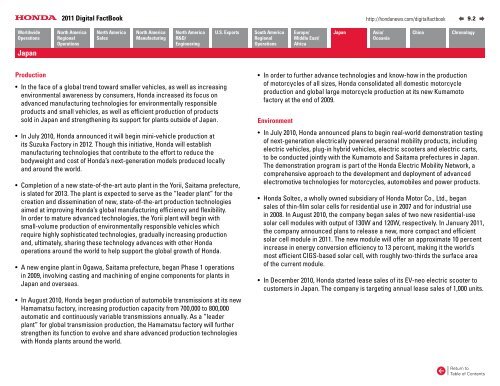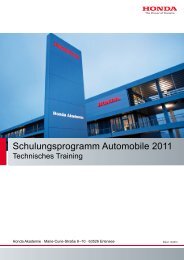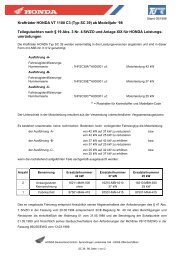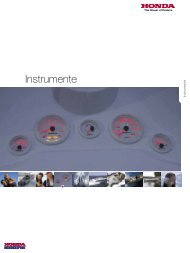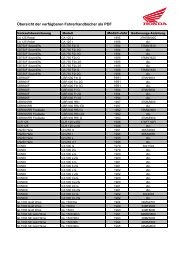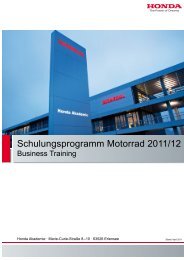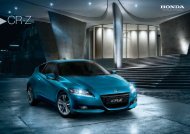2011 Digital Fact Book - Honda
2011 Digital Fact Book - Honda
2011 Digital Fact Book - Honda
- TAGS
- digital
- honda
- www.honda.com
You also want an ePaper? Increase the reach of your titles
YUMPU automatically turns print PDFs into web optimized ePapers that Google loves.
Japan<br />
Production<br />
• In the face of a global trend toward smaller vehicles, as well as increasing<br />
environmental awareness by consumers, <strong>Honda</strong> increased its focus on<br />
advanced manufacturing technologies for environmentally responsible<br />
products and small vehicles, as well as efficient production of products<br />
sold in Japan and strengthening its support for plants outside of Japan.<br />
• In July 2010, <strong>Honda</strong> announced it will begin mini-vehicle production at<br />
its Suzuka <strong>Fact</strong>ory in 2012. Though this initiative, <strong>Honda</strong> will establish<br />
manufacturing technologies that contribute to the effort to reduce the<br />
bodyweight and cost of <strong>Honda</strong>’s next-generation models produced locally<br />
and around the world.<br />
• Completion of a new state-of-the-art auto plant in the Yorii, Saitama prefecture,<br />
is slated for 2013. The plant is expected to serve as the “leader plant” for the<br />
creation and dissemination of new, state-of-the-art production technologies<br />
aimed at improving <strong>Honda</strong>’s global manufacturing efficiency and flexibility.<br />
In order to mature advanced technologies, the Yorii plant will begin with<br />
small-volume production of environmentally responsible vehicles which<br />
require highly sophisticated technologies, gradually increasing production<br />
and, ultimately, sharing these technology advances with other <strong>Honda</strong><br />
operations around the world to help support the global growth of <strong>Honda</strong>.<br />
• A new engine plant in Ogawa, Saitama prefecture, began Phase 1 operations<br />
in 2009, involving casting and machining of engine components for plants in<br />
Japan and overseas.<br />
• In August 2010, <strong>Honda</strong> began production of automobile transmissions at its new<br />
Hamamatsu factory, increasing production capacity from 700,000 to 800,000<br />
automatic and continuously variable transmissions annually. As a “leader<br />
plant” for global transmission production, the Hamamatsu factory will further<br />
strengthen its function to evolve and share advanced production technologies<br />
with <strong>Honda</strong> plants around the world.<br />
http://hondanews.com/digitalfactbook 9.2<br />
• In order to further advance technologies and know-how in the production<br />
of motorcycles of all sizes, <strong>Honda</strong> consolidated all domestic motorcycle<br />
production and global large motorcycle production at its new Kumamoto<br />
factory at the end of 2009.<br />
Environment<br />
• In July 2010, <strong>Honda</strong> announced plans to begin real-world demonstration testing<br />
of next-generation electrically powered personal mobility products, including<br />
electric vehicles, plug-in hybrid vehicles, electric scooters and electric carts,<br />
to be conducted jointly with the Kumamoto and Saitama prefectures in Japan.<br />
The demonstration program is part of the <strong>Honda</strong> Electric Mobility Network, a<br />
comprehensive approach to the development and deployment of advanced<br />
electromotive technologies for motorcycles, automobiles and power products.<br />
• <strong>Honda</strong> Soltec, a wholly owned subsidiary of <strong>Honda</strong> Motor Co., Ltd., began<br />
sales of thin-film solar cells for residential use in 2007 and for industrial use<br />
in 2008. In August 2010, the company began sales of two new residential-use<br />
solar cell modules with output of 130W and 120W, respectively. In January <strong>2011</strong>,<br />
the company announced plans to release a new, more compact and efficient<br />
solar cell module in <strong>2011</strong>. The new module will offer an approximate 10 percent<br />
increase in energy conversion efficiency to 13 percent, making it the world’s<br />
most efficient CIGS-based solar cell, with roughly two-thirds the surface area<br />
of the current module.<br />
• In December 2010, <strong>Honda</strong> started lease sales of its EV-neo electric scooter to<br />
customers in Japan. The company is targeting annual lease sales of 1,000 units.


